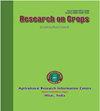Impact of rice straw biochar and reduced chemical fertilizer on the growth and yield of rice (Oryza sativa L.) in Central Vietnam
Q3 Agricultural and Biological Sciences
引用次数: 0
Abstract
One way to effectively use rice straw without causing environmental pollution is to produce biochar and reuse it to improve rice yield and soil properties. Using rice straw biochar has increased rice productivity and can reduce chemical fertilizers. Therefore, this study aimed to evaluate the effects of rice straw biochar application with reduced chemical fertilizer on the growth and yield of rice at Quang Phu commune, Quang Dien district, Thua Thien Hue province, Vietnam with four treatments of the co-application of rice straw biochar doses of 5, 7.5 and 10 t/ha and chemical fertilizers of 75, 50 and 25% of the recommended dose. Growth parameters, yield components, yield of rice, and soil property were investigated. The results showed that the rice straw biochar had a positive effect on the growth, yield of rice, and soil properties. The co-application of rice straw biochar of the level of 10 t/ha and chemical fertilizer of 25% of the recommended dose was optimal levels produced the highest growth and yield (63 t/ ha). The co-application of rice straw biochar and chemical fertilizers increased organic matter, improved both soil physical and chemical properties, and reduced chemical fertilizer use. As a result, the rice straw biochar may be recommended to farmers to apply for rice production.稻草生物炭和减少化肥用量对越南中部水稻(Oryza sativa L.)生长和产量的影响
在不造成环境污染的情况下有效利用稻草的方法之一是生产生物炭,并将其再利用,以提高水稻产量和改善土壤性质。使用稻草生物炭可以提高水稻产量,减少化肥用量。因此,本研究旨在评估在越南 Thua Thien Hue 省 Quang Dien 县 Quang Phu 乡施用水稻秸秆生物炭并减少化肥用量对水稻生长和产量的影响,共采用了四种处理方法,即水稻秸秆生物炭剂量为 5 吨/公顷、7.5 吨/公顷和 10 吨/公顷,化肥用量为建议剂量的 75%、50% 和 25%。研究了生长参数、产量成分、水稻产量和土壤特性。结果表明,稻草生物炭对水稻的生长、产量和土壤性质有积极影响。水稻秸秆生物炭的施用量为 10 吨/公顷,化肥的施用量为推荐剂量的 25%,这两种肥料的最佳施用量产生了最高的生长和产量(63 吨/公顷)。稻草生物炭和化肥的共同施用增加了有机质,改善了土壤的物理和化学性质,减少了化肥的使用。因此,可以建议农民将稻草生物炭用于水稻生产。
本文章由计算机程序翻译,如有差异,请以英文原文为准。
求助全文
约1分钟内获得全文
求助全文
来源期刊

Research on Crops
Agricultural and Biological Sciences-Soil Science
CiteScore
1.50
自引率
0.00%
发文量
93
审稿时长
1 months
期刊介绍:
The Research on Crops is a peer-reviewed journal publishing original research papers, review articles and short communications in English on all basic and applied aspects of crop sciences, agricultural water management, agro-climatology, agroforestry, agronomy, crop production, crop protection, cropping systems, food science & technology, genetics & plant breeding, horticulture, plant & soil science, plant biotechnology, plant nutrition, post-harvest management of crops, seed science, soil management & tillage, vegetables, weed science, agricultural engineering, agri-business, agricultural economics and extension, etc. The aim of the journal is to provide a forum for the scientific community to publish their latest research findings.
The manuscripts submitted for publication should not contain data older than 4 years on the date of submission.
The articles submitted for publication in this journal should not be submitted elsewhere simultaneously for publication in another journal. These should not carry any copyright material without prior permission of copyright holder.
The articles should present a complete picture of the investigation made and should not be split into parts.
There is no prescribed limit regarding the number of pages in case of full-length articles. However, the authors are advised to keep the length of their articles from 4 to 10 full printed pages of the journal.
The articles should be divided into the sub-sections: ABSTRACT, INTRODUCTION, MATERIALS AND METHODS, RESULTS AND DISCUSSION, CONCLUSIONS, and REFERENCES. Tables and figures should be appended separately at the end.
 求助内容:
求助内容: 应助结果提醒方式:
应助结果提醒方式:


